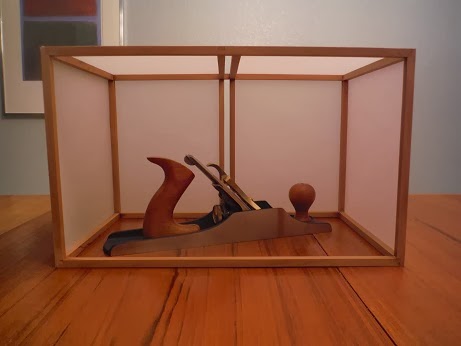At the end of the week, near the end of the game the score is Wenge – 1 and Pete – 0.
This week’s box (three boxes actually) was intended to be a
small Wenge box with a Marblewood sliding lid.
The corner joinery was to be a half-lap/shoulder scheme with Maple dowel
pegs. This week has actually been a
painful lesson in the highly difficult nature of working with Wenge, especially
when it is quarter sawn. As beautiful as
it is to look at it, is a chipping, splintering, almost shattering nightmare…or
I just need more practice and patience.
Surely it’s the wood’s fault though.
With all the pieces milled to size, I had set about to start
with the joinery.
First I set up a 1/8 inch straight bit in the router table to cut a stopped rabbet into the bottom of each box side to receive an inset lid, another first for me on this project.
These went fairly well, however a few passes on some test pieces gave me quite a scare with some serious chipping at the end of the cuts.
The real struggle came when cutting the shoulders of the corner joints. A sharp, flat-toothed grind blade with the support of a crosscut sled was not enough. Severing the wood fibers with a marking knife was not enough. Even cutting a line with a chisel and then paring some relief to that line was not enough.
Despite several different efforts this testy wood did not cooperate.
Almost all of the pieces experienced tear-out and splintering on the inside faces of the shoulder joints. Even with several extra pieces handy, there were not enough to make even one clean box.
First I set up a 1/8 inch straight bit in the router table to cut a stopped rabbet into the bottom of each box side to receive an inset lid, another first for me on this project.
These went fairly well, however a few passes on some test pieces gave me quite a scare with some serious chipping at the end of the cuts.
The real struggle came when cutting the shoulders of the corner joints. A sharp, flat-toothed grind blade with the support of a crosscut sled was not enough. Severing the wood fibers with a marking knife was not enough. Even cutting a line with a chisel and then paring some relief to that line was not enough.
Despite several different efforts this testy wood did not cooperate.
Almost all of the pieces experienced tear-out and splintering on the inside faces of the shoulder joints. Even with several extra pieces handy, there were not enough to make even one clean box.
In a last defiant push, I was able to thumb my nose at Wenge
and salvage enough from the carnage to build this all-Wenge lift lid box. The corners are mitered and pegged with Maple
dowels, located in the same orientation as the original intended shoulder
joints. The sliding Marblewood lid is
replaced with a Wenge lift lid slab, and even the bottom (which was intended to
be a Baltic Birch inset panel, covered in felt) is solid Wenge. I’m still torn on the title for this one…either
“Black Box” or “Take that Wenge!”
It wasn’t a pretty outing this week, but I do believe I’ve
settled the score…until we meet again!
Pete










































